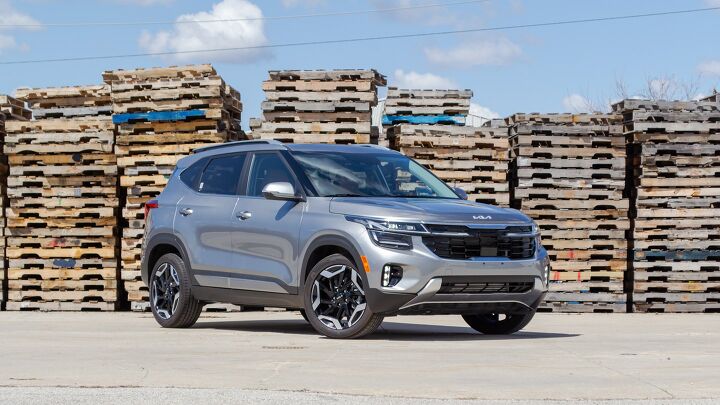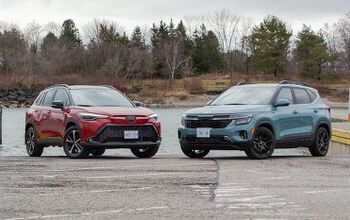Kia Seltos vs Volkswagen Taos Comparison: The Inbetweeners

If you caught our 11 small SUV mega-comparison, you're probably wondering: why bother with this face-off?
On the surface, that's fair. The Seltos emerged victorious there, but the top five were all pretty close—a testament to the breadth of talent in the segment. Both the Taos and Seltos have a similar approach too: they're the more conservative, premium felling small SUVs. These not-so-little crossovers care about rear seat passengers and cargo almost as much as those sitting up front.
It might've finished fourth, but the Taos still has a thing or two to teach the Seltos. So just as we did with the Trailblazer and Trax, editor Mike Schlee and I are picking sides: he's on the Seltos squad, and I'm team Taos.
Interior and Exterior:
The 2024 Volkswagen Taos is the Best Small SUV for Big Families
Taos: True to VW form, the Taos design is either safely handsome or mildly indistinct, depending on your perspective. One thing it can lord over the Kia though: it pioneered the quasi-light bar front-end design the Seltos also now has! While I like the Taos' stormtrooper-like color scheme for the necessary contrast it provides, I'm still not sold on black wheels. They're overdone.
Just as it is outside, the Taos is all sober German design inside. The dashboard design uses gratuitous piano black, but it’s an area I never plan on touching, so it’s almost passable. Almost. I appreciate the gray soft-touch with contrasting blue trim, and the storage cubby atop the dash, even if anything put there makes a racket.
Both Schlee and I are big fans of the Taos' seats. Volkswagen employs a smart mix of leatherette, cloth, and faux-suede here, resulting in great-feeling thrones that hold folks in place without oversized bolsters.
The Taos—and the Seltos—goes for a more boxy, upright look than most of the class, which pays off with excellent rear passenger space. The low shoulder line also lets in plenty of natural light in both rows. As good as the Seltos can be on that front, the VW has the best back-seat in the game, with acres of legroom, a roof that doesn’t close in on passenger’s temples, and an enormous panoramic moonroof. Genuinely, it’s better than most of the options the next size up. Well, except for the solo USB-C port back there.
Cargo space is only slightly down on the Seltos, with 24.9 cubic feet (705 liters) when the rear row is up, and a huge 60.2 cu ft (1,705 L) with them down.
The 2024 Kia Seltos is a Small SUV For Over-Achievers
Seltos: The exterior of the Seltos is also a conservative design, especially when compared to some of Kia’s other outlandish SUVs. The Seltos has the sort of shape and style that should age well, shouldn’t offend anyone, and just blend nicely into traffic.
Inside, it’s much the same with a premium, yet restrained look. Mike really likes the materials used and the overall style of the dashboard. The Seltos earns early points for having a whole bunch of actual, physical buttons, too. Even where some lower rent materials are used, like lower down the dashboard or along the rear doors, Kia has used clever textures to mostly mask 'em.
Neither of us particularly like the Seltos' perch-like seating position, with Schlee comparing it to a dining chair. Shorter drivers should appreciate the visibility it provides, mind you. And even though he's six-foot, Schlee has enough headroom in the Seltos.
These two are the most spacious small SUVs out there. The Seltos' rear bench is a pretty swell place for adults, with lots of head- and legroom, soft and ample armrests, and good outward visibility. There's just one thing it lacks compared to the VW: a big pano roof to complete the greenhouse experience.
Even though the Seltos gives up a few inches in overall length to its German competitor, it still has the edge on cargo space. We're talking 26.6 cu ft (753 L), or 62.8 cu ft (1,778 L) when running in two-row form. The only competitor to get close to those figures? Surprise surprise: it's the Taos.
Powertrain and Driving Dynamics
Taos: The Taos uses a tiny 1.5-liter turbo-four, and it is notably down on horsepower here; with 158 hp, it’s a 37-pony gap. That’s okay; the Taos’ torque figure nearly matches the Kia’s, and we all know it's the torque that determines the day-to-day driving experience. The seven-speed dual-clutch plays a game of give-and-take against the Kia’s eight-speed automatic. On one hand, the Taos is more responsive, as the Seltos’ stubborn refusal to kick down can leave drivers out to dry. On the other, the dual-clutch is all jerky in low-speed maneuvering, making parking lot navigation needlessly annoying.
VW's little engine is capable of incredible, near-hybrid levels of fuel economy in the Jetta, and the Taos isn't far off. A longer drive home from our super-secret testing spot saw the VW comfortably beat its official highway rating (32 mpg / 7.4 L/100 km). On the other hand, the Seltos is one of the thirstiest in the segment, with a highway rating to match its much larger Sorento sibling—a vehicle with an extra 90 horsepower and entire row of seats.
The Taos isn't all fuel-sipping, either. It has that properly grown-up feel that the Germans excel at, soaking up bumps despite the large 19-inch alloys. It's not the most fun in the segment—that'd be a Mazda CX-30—but it's not far off, and remains composed and in control. The steering and brakes both inspire confidence, with predictable and consistent weighting.
Seltos: This is Mike's turn to gloat. "While Kyle has only a measly 1.5-liters of turbo power, I have an enormous 1.6-liters," beams Schlee. "I also have a heck of a lot more horsepower, 195 in total which is almost 40 more than Kyle in the Volkswagen." If we're continuing the counting, the Seltos also has one more cog in its auto 'box than the Taos does in its DCT.
On the road, the Seltos makes its power advantage known, and progress is generally smooth. There is one area I can't ignore, and that's the eight-speed's reluctance to kick down on full-throttle applications. On more than a few occasions, the Seltos would wait entire seconds before selecting the proper gear.
Fuel economy is... not great. Sure, in the city it's fine, where the Seltos even slightly beats the Taos in its official figures: 25 mpg (9.4 L/100 km) to 24 mpg (9.9 L/100 km). But as covered above, its highway figure is atrocious.
I'll let Mike cover the driving dynamics. "The only other real weak spot for the Seltos is the chassis," he confirms. "Although it is comfortable enough, it’s not as compliant as the Taos, and doesn’t feel as sharp when cornering either."
Tech, Safety, and Features
Taos: Are you a person of taste, and thus find VW’s latest infotainment system off-putting? Well good news, as the Taos continues to use the previous system, which is straightforward and features permanent buttons dotting the screen sides. Huzzah! The system is easy to use and slick in its responses. VW doesn't lock wireless Apple CarPlay to only smaller, low-trim screens, either.
Now it's no secret Kia bundles in a ton of creature comforts in its cars. And it’s true, there are some the Taos is missing. This is only the mid-level trim however, and it still gets a few goodies you won’t find on the Kia, like dual-zone climate control for starters. I can’t forget about the customizable ambient lighting however, or the adaptive headlights.
A standard safety suite includes the expected driver assists, such as lane-keep, blind-spot monitoring, and rear cross-traffic alert. The VW’s adaptive cruise control is very natural in execution, but it lacks the fancy GPS augmentation you’ll find in the Kia. How much does that matter? In practice, not much.
Seltos: Despite the lower as-tested price—in the US, not Canada—the Seltos is packed full of premium features, some not found in our Taos tester. Going Korean means getting front ventilated seats, a power-adjustable front passenger seat, and a head-up display. The latter uses a fold-out panel, but still: it works. While both trucklets employ a digital instrument cluster, the Seltos' sits alongside the central touchscreen in one unbroken frame, which does look slicker. The one big miss is dual-zone climate control, which is an odd omission.
As this is the top Seltos trim, all the expected safety gear is standard, like blind-spot warning, forward collision warning and assist, rear cross traffic alert, lane departure warning, lane keep assist, driver attention warning, and so on. The GPS-based cruise control features stop-and-go plus curve assist functions.
Pricing and Value
Taos: As equipped, this Taos SE Black rings in at $33,835 in America, destination included, or about a grand more than the Kia. In Canada it’s $37,495 CAD… almost the exact same gap, but in the Taos’ favor.
Seltos: This fully optioned Seltos SX continues to offer a lot of bang for your buck. Including destination charges, this tester would ring in at $32,665 in America, slightly undercutting the Taos. In Canada, its $38,544 as-tested price makes it the spendier choice. It's important to point out that the Taos can go higher still with its top trim, however.
Conclusion: Kia Seltos vs Volkswagen Taos Comparison
As we covered in that original 11-vehicle comparison, there is no One Right Answer, no single small SUV that satisfies everyone's needs. The Seltos came closest, and it won our comparison—but that doesn't necessarily mean it's right for you.
The Volkswagen Taos has a lot going for it, with a huge and well-appointed cabin combined with mature driving dynamics. It's a sensible choice.
Except folks don't buy on sensible, or rational. Both Mike and I know the Seltos out-scored the Taos in that comparo, but in this head-to-head, we lean VW, and not because of numbers on a sheet. "If you asked me why, I probably couldn’t give you a proper answer, it’s just my choice," explains Schlee.
Whether you pick Taos or Seltos, both are great choices for buyers looking for spacious, comfortable, and quietly conservative small SUVs.
Become an AutoGuide insider. Get the latest from the automotive world first by subscribing to our newsletter here.

Kyle began his automotive obsession before he even started school, courtesy of a remote control Porsche and various LEGO sets. He later studied advertising and graphic design at Humber College, which led him to writing about cars (both real and digital). He is now a proud member of the Automobile Journalists Association of Canada (AJAC), where he was the Journalist of the Year runner-up for 2021.
More by Kyle Patrick










































Comments
Join the conversation
Which one of these iddy biddy over stressed turbo fours will blow up first. Based upon recent history my money is on the KIA. Having experience with both brands I would not have either one in my garage.
Seltos is a terrible name for a vehicle